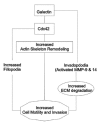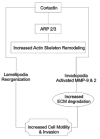Molecular changes in invasive front of oral cancer
- PMID: 24250086
- PMCID: PMC3830234
- DOI: 10.4103/0973-029X.119740
Molecular changes in invasive front of oral cancer
Abstract
Treatment planning for oral squamous cell carcinoma (OSCC) is based on the clinical TNM (Tumor, Node and Metastasis) classification. This system operates on the assumption that small tumours without clinical spread have a better prognosis than larger tumours with metastases. However, it is a well-known fact that some tumours with the same clinical staging show different growth patterns and clinical behaviour. This makes the prognosis for patients with OSCC difficult to predict on the basis of clinical staging alone. Although many histopathological characteristics of OSCC have been identified as prognostic factors, none is believed to be completely infallible. Therefore, a great need exists for more reliable prognostic markers, which will assist in treatment decisions. It is now well documented that several molecular events of significance for tumour spread, such as gain and loss of adhesion molecules, secretion of proteolytic enzymes, increased cell proliferation and initiation of angiogenesis occur at the tumour-host interface or invasive front, where the deepest and presumably most aggressive cells reside. This review describes the various molecular events and interactions, which take place in the invasive front of the OSCC, and elucidates their role as prognostic markers.
Keywords: Head and neck; invasive front; molecular markers; squamous cell carcinoma.
Conflict of interest statement
Figures
Similar articles
-
Is the invasive front of an oral carcinoma the most important area for prognostication?Oral Dis. 1998 Jun;4(2):70-7. doi: 10.1111/j.1601-0825.1998.tb00260.x. Oral Dis. 1998. PMID: 9680893 Review.
-
The invasive front of carcinomas. The most important area for tumour prognosis?Anticancer Res. 1998 Nov-Dec;18(6B):4757-64. Anticancer Res. 1998. PMID: 9891553 Review.
-
Histologic grading of the tumor/tissue interface to predict lymph node metastasis in squamous cell carcinoma of the tongue.Dent Med Probl. 2020 Jul-Sep;57(3):233-238. doi: 10.17219/dmp/119937. Dent Med Probl. 2020. PMID: 33113294
-
Correlation of Clinical and Pathological TNM Staging With Histopathological Grading in Oral Squamous Cell Carcinoma.Cureus. 2024 May 23;16(5):e60912. doi: 10.7759/cureus.60912. eCollection 2024 May. Cureus. 2024. PMID: 38910661 Free PMC article.
-
Prognostic factors of survival rate in oral squamous cell carcinoma: clinical, histologic, genetic and molecular concepts.Arch Iran Med. 2015 May;18(5):314-9. Arch Iran Med. 2015. PMID: 25959914 Review.
Cited by
-
Proteomic Markers for Mechanobiological Properties of Metastatic Cancer Cells.Int J Mol Sci. 2023 Mar 1;24(5):4773. doi: 10.3390/ijms24054773. Int J Mol Sci. 2023. PMID: 36902201 Free PMC article. Review.
-
Spatial transcriptomics reveals distinct and conserved tumor core and edge architectures that predict survival and targeted therapy response.Nat Commun. 2023 Aug 18;14(1):5029. doi: 10.1038/s41467-023-40271-4. Nat Commun. 2023. PMID: 37596273 Free PMC article.
-
Lactobacillus fermentum and Lactobacillus crispatus Do Not Have Cytotoxic Effects on HN5 Oral Squamous Cell Carcinoma Cell Line.Int J Dent. 2021 Sep 28;2021:3034068. doi: 10.1155/2021/3034068. eCollection 2021. Int J Dent. 2021. PMID: 34621315 Free PMC article.
-
Inferring causal trajectories from spatial transcriptomics using CASCAT.Nucleic Acids Res. 2025 Aug 11;53(15):gkaf791. doi: 10.1093/nar/gkaf791. Nucleic Acids Res. 2025. PMID: 40829806 Free PMC article.
-
Expression of p53 at invasive front of oral squamous cell carcinoma and negative histopathological surgical margins to establish correlation at 3-year survival.J Oral Maxillofac Pathol. 2020 Sep-Dec;24(3):582. doi: 10.4103/jomfp.JOMFP_106_20. Epub 2021 Jan 9. J Oral Maxillofac Pathol. 2020. PMID: 33967511 Free PMC article.
References
-
- Broder AC. Carcinoma of the mouth: Types and degrees of malignancy. Am J Roentgenol Radium Ther Nucl Med. 1927;17:90–3.
-
- Bryne M, Nielsen K, Koppang HS, Dabelsteen E. Reproducibility of two malignancy grading systems with reportedly prognostic value for oral cancer patients. J Oral Pathol Med. 1991;20:369–72. - PubMed
-
- Umeda M, Nishimatsu N, Teranobu O, Shimada K. Criteria for diagnosing lymph node metastasis from squamous cell carcinoma of oral cavity study of relationship between computed tomographic and histologic findings and outcome. J Oral Maxillofac Surg. 1998;56:585–93. - PubMed
-
- Giacomarra V, Tirelli G, Papanikolla L, Bussani R. Predictive factors of nodal metastasis in oral cavity and oropharynx carcinomas. Laryngoscope. 1999;109:795–9. - PubMed
-
- Willen R, Nathanson A, Moberger G, Anneroth G. Squamous cell carcinoma of the gingiva. Histological classification and grading of malignancy. Acta Otolaryngol. 1975;79:146–54. - PubMed
Publication types
LinkOut - more resources
Full Text Sources
Other Literature Sources



